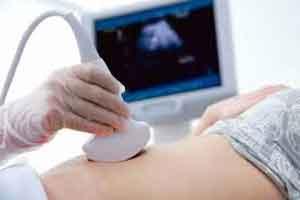- Home
- Editorial
- News
- Practice Guidelines
- Anesthesiology Guidelines
- Cancer Guidelines
- Cardiac Sciences Guidelines
- Critical Care Guidelines
- Dentistry Guidelines
- Dermatology Guidelines
- Diabetes and Endo Guidelines
- Diagnostics Guidelines
- ENT Guidelines
- Featured Practice Guidelines
- Gastroenterology Guidelines
- Geriatrics Guidelines
- Medicine Guidelines
- Nephrology Guidelines
- Neurosciences Guidelines
- Obs and Gynae Guidelines
- Ophthalmology Guidelines
- Orthopaedics Guidelines
- Paediatrics Guidelines
- Psychiatry Guidelines
- Pulmonology Guidelines
- Radiology Guidelines
- Surgery Guidelines
- Urology Guidelines
Routine third trimester ultrasound in low-risk pregnancies has no benefit, finds BMJ study

Netherlands-Fetal growth restriction is a risk factor for perinatal mortality and morbidity and cardiovascular disease and neurodevelopmental disorders in adulthood. Therefore routine ultrasonography in the third trimester detects neonates who are small for gestational age (SGA) significantly more often than usual care using serial fundal height measurements combined with clinically indicated ultrasonography. Many professionals like ultrasound and seem to believe that a universal screening strategy must be superior to a selective strategy to achieve good neonatal and long-term health outcomes but the evidence that routine ultrasonography in the third trimester reduces the incidence of severe adverse perinatal outcomes is lacking.
A new study has found that in low-risk pregnancies, routine ultrasonography in the third trimester combined with clinically indicated ultrasonography was associated with greater antenatal detection of small-for-gestational-age neonates and induction of labour but was not associated with a reduction in severe adverse perinatal outcomes compared with usual care.
The study involved 13 046 women aged 16 years or older with a low-risk singleton pregnancy and in the study 60 midwifery practices offered usual care (serial fundal height measurements with clinically indicated ultrasonography). After 3, 7, and 10 months, a third of the practices were randomised to the intervention strategy. As well as receiving usual care, women in the intervention strategy were offered two routine biometry scans at 28-30 and 34-36 weeks’ gestation. The same multidisciplinary protocol for detecting and managing fetal growth restriction was used in both strategies.
The primary outcome measure was a composite of severe adverse perinatal outcomes: perinatal death, Apgar score <4, impaired consciousness, asphyxia, seizures, assisted ventilation, septicaemia, meningitis, bronchopulmonary dysplasia, intraventricular haemorrhage, periventricular leucomalacia, or necrotising enterocolitis. Secondary outcomes were two composite measures of severe maternal morbidity, and spontaneous labour and birth.
The researchers organised enrollment of 13 520 women in mid-pregnancy between 1 February 2015 and 29 February 2016 by 60 midwifery practices. 13 046 women with data based on the national Dutch perinatal registry or hospital records were included in the analyses. Small for gestational age at birth was significantly more often detected in the intervention group than in the usual care group. The incidence of severe adverse perinatal outcomes was 1.7% for the intervention strategy and 1.8% for usual care. After adjustment for confounders, the difference between the groups was not significant. The intervention strategy showed a higher incidence of induction of labour and a lower incidence of augmentation of labour. Maternal outcomes and other obstetric interventions did not differ between the strategies.
The researchers concluded that in low-risk pregnancies, routine ultrasonography in the third trimester along with clinically indicated ultrasonography was associated with higher antenatal detection of small for gestational age fetuses but not with a reduced incidence of severe adverse perinatal outcomes compared with usual care alone. Based on these findings, routine ultrasonography has no benefit (or harm) to the neonate but was associated with a moderately increased incidence of induction of labour.The findings do not support routine ultrasonography in the third trimester for low-risk pregnancies.
For further reference log on to :
https://doi.org/10.1136/bmj.l5517
Trial registration Netherlands Trial Register NTR4367.

Disclaimer: This site is primarily intended for healthcare professionals. Any content/information on this website does not replace the advice of medical and/or health professionals and should not be construed as medical/diagnostic advice/endorsement or prescription. Use of this site is subject to our terms of use, privacy policy, advertisement policy. © 2020 Minerva Medical Treatment Pvt Ltd